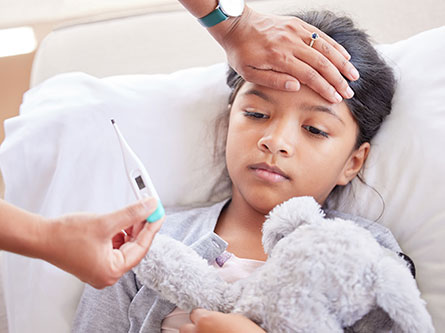There's been a rise in measles cases in the United States. That's led some people to go to an emergency department if they suspect they or their children have symptoms.
However, in an effort to prevent spreading measles, our Emergency Department providers want you to know a few things before you seek care.
1. Measles is highly contagious
Measles is an airborne disease that lives in mucus in the nose and throat. It's spread when an infected person breathes, coughs or sneezes. Measles can be spread up to two hours after an infected person has left the room because it can linger in the air.
Find out more about measles spread and how to protect your family
2. Check for measles symptoms
Early symptoms of measles include:
- High fever (may reach more than 104°F)
- Cough
- Runny nose
- Watery eyes
After a few days of being infected with measles, you may notice these symptoms:
- White spots in mouth.
- Flat or raised red spots that usually start on the face and spread down to the rest of the body. On dark skin, the spots may appear purple or darker than the surrounding skin.
Other complications from measles, especially in children under 5, include ear infections and diarrhea.
Read more about measles symptoms, treatment and prevention
3. Call your doctor's office before you come in
Call your health care provider's office to discuss your symptoms and let them know if you are coming. If you don't have a primary care provider, call your county's public health department.
Calling first can help your provider's clinic decide how to protect other patients and staff from being exposed to measles.
Learn if you should go to the emergency room (ER), urgent care or doctor's office
4. Wear a mask if you believe you have measles
Patients ages 2 and older should wear a mask. N95s or KN95s are best, but any mask is better than none. Masks can help reduce the spread of measles in the air.
Sign up for our Health Highlights e-newsletter
5. Wait to be brought inside
If possible, call when you arrive at the doctor's office or hospital. Some providers might ask you to wait in your vehicle instead of sitting in a waiting room where you could expose others.
If you go to an emergency department, let them know of your measles concerns. You may be brought to an isolation room to avoid potential spread to people in the waiting room.
See how you can get life-saving care in our Emergency Department
6. Try to know if you've had a measles vaccine
It's useful for the care team to know if you have had the measles, mumps and rubella (MMR) vaccine. You can check with your health care provider to see if your vaccine history is available.
The first dose of the MMR vaccine is typically given to babies ages 12-15 months. The second dose is given between ages 4 and 6.
People who have received two doses of the MMR vaccine are overwhelmingly protected from the measles. However, a very small number, about 3 in 100 people who get both doses, will still be susceptible to infection. Experts strongly recommend patients to be fully vaccinated.
Learn more about the MMR vaccine and how it can protect your family from measles
This blog has been medically reviewed by emergency medicine physician James Holmes and Chief of Pediatric Infectious Diseases Dean Blumberg.




